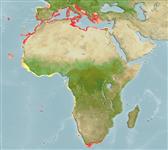Common names from other countries
Environment: milieu / climate zone / depth range / distribution range
Écologie
; profondeur 1 - 110 m (Ref. 85345). Subtropical; 46°N - 37°S, 26°W - 32°E
Distribution
Pays | Zones FAO | Écosystèmes | Occurrences | Introductions
Eastern Atlantic and the Mediterranean.
Length at first maturity / Taille / Poids / Âge
Maturity: Lm ? range ? - ? cm Max length : 60.0 cm WD mâle / non sexé; (Ref. 114251)
Maximum length is in body diameter (Ref. 114251). Infaunal; found on sandy substrates (Refs 106821, 106822). Common on bottoms covered with seagrasses and also occurs on detritic and muddy bottoms (Ref. 106822). Main diet include gastropods and bivalves (Ref. 106164).
Life cycle and mating behavior
Maturité | Reproduction | Frai | Œufs | Fécondité | Larves
Members of the class Asteroidea exhibit both asexual (regeneration and clonal) and sexual (gonochoric) means of reproduction. Life cycle: Embryos hatch into planktonic larvae and later metamorphose into pentamorous juveniles which develop into young sea stars with stubby arms.
MarineSpecies.org. 2050. (Ref. 3477)
Statut dans la liste rouge de l'IUCN (Ref. 130435)
statut CITES (Ref. 108899)
Not Evaluated
Not Evaluated
Menace pour l'homme
Harmless
Utilisations par l'homme
| FishSource |
Outils
Plus d'informations
Taille/Âge
Croissance
Longueur-poids
Longueur-longueur
Morphologie
Larves
Abondance
Sources Internet
Estimates based on models
Preferred temperature
(Ref.
115969): 14.3 - 21, mean 18.2 (based on 276 cells).
